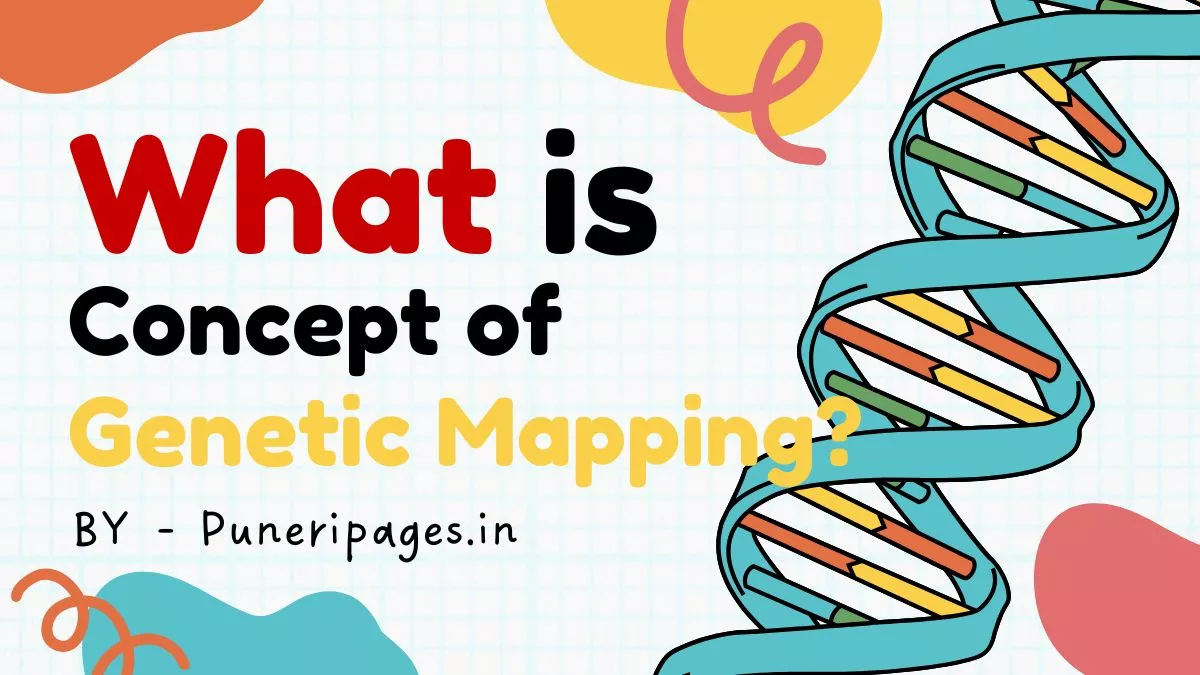
A conceptual visualization of Genetic Mapping — the scientific process of identifying gene locations on DNA strands. Image by puneripages.in.
By Prashant for PuneriPages.in
Genetic mapping, also known as gene mapping, is one of the most transformative concepts in modern biology and genetics. It provides a scientific roadmap for identifying the positions of genes on chromosomes and understanding how these genes influence inherited traits. Through this process, researchers can trace genetic disorders, improve crop breeding, and even tailor medical treatments to an individual’s DNA.
In this comprehensive guide, we’ll explore what genetic mapping is, how it works, its techniques, applications, and future implications for both medicine and biotechnology.
Table of Contents
Understanding the Concept of Genetic Mapping
At its core, genetic mapping refers to the process of determining the specific location or locus of genes on a chromosome. Every living organism has DNA composed of genes that control traits and biological functions. By mapping these genes, scientists can create a genetic map—a diagram that shows how genes are arranged and how frequently they are inherited together.
These maps serve as essential tools for understanding the structure and function of genomes, allowing geneticists to identify gene linkage, study mutations, and analyze hereditary diseases.
Types of Genetic Maps
There are two primary types of genetic maps—linkage maps and physical maps. Both serve different purposes but complement each other in genetic research.
1. Linkage Maps
A linkage map shows the relative positions of genes based on the frequency of recombination during meiosis. When two genes are located close to each other on a chromosome, they are more likely to be inherited together.
Scientists use recombination frequency as a unit of measurement, expressed in centimorgans (cM). A smaller recombination rate indicates that genes are located closer together.
2. Physical Maps
A physical map, on the other hand, measures the actual physical distance between genes in base pairs. This method uses molecular techniques, such as DNA sequencing, to pinpoint the exact location of genes.
While linkage maps give a statistical relationship, physical maps provide precise structural details of chromosomes.
The Process of Genetic Mapping
The process of creating a genetic map involves several steps that blend classical genetics and modern molecular biology:
1. Collection of Genetic Data
Scientists begin by collecting DNA samples from individuals, families, or organisms with known genetic traits. The differences or similarities between their genes provide the foundation for analysis.
2. Identification of Genetic Markers
Genetic markers are identifiable DNA sequences used to track inheritance patterns. Common markers include microsatellites, single nucleotide polymorphisms (SNPs), and restriction fragment length polymorphisms (RFLPs).
3. Analyzing Recombination Frequencies
Through crossbreeding experiments or pedigree studies, scientists examine how often recombination occurs between markers. The lower the recombination frequency, the closer the genes are to each other.
4. Constructing the Genetic Map
Once the data is collected, bioinformatic tools and algorithms are used to generate a linear map showing the relative positions of genes and their distances. This serves as a visual guide to the organism’s genome.
Key Techniques Used in Genetic Mapping
Over the years, advancements in biotechnology have revolutionized how genetic maps are constructed. The most widely used techniques include:
1. Linkage Analysis
Linkage analysis is a statistical approach that evaluates how genetic traits or markers co-segregate within families. It is essential for identifying genes responsible for hereditary diseases such as cystic fibrosis or Huntington’s disease.
2. Genome-Wide Association Studies (GWAS)
GWAS is a modern, high-throughput technique used to scan the genome for genetic variants associated with diseases or traits. It allows researchers to study thousands of individuals simultaneously, providing a comprehensive overview of genetic diversity.
3. Radiation Hybrid Mapping
This method involves fragmenting chromosomes using radiation and determining which fragments contain specific markers. It’s useful for mapping large genomes where traditional recombination methods may fail.
4. Fluorescent In Situ Hybridization (FISH)
FISH uses fluorescent probes that bind to specific DNA sequences, enabling scientists to visually locate genes under a microscope. It provides a more direct and visual representation of gene positions.
Applications of Genetic Mapping
The applications of genetic mapping are vast and touch nearly every field of biological science:
1. Medical Research and Genetic Disorders
One of the most crucial uses of genetic mapping lies in identifying genes responsible for genetic disorders. By locating defective genes, doctors can predict disease risks, improve diagnosis accuracy, and develop targeted gene therapies.
For example, mapping helped locate the BRCA1 and BRCA2 genes, which are linked to breast and ovarian cancer.
2. Agriculture and Crop Improvement
In agriculture, genetic mapping is vital for plant breeding programs. It allows scientists to identify genes responsible for drought resistance, yield improvement, and disease resistance, making crops more sustainable and productive.
3. Evolutionary Biology
Genetic maps help trace evolutionary relationships among species by comparing genome structures. These maps can reveal how species evolved over time and how genetic traits diversified.
4. Personalized Medicine
With the rise of genomic sequencing, genetic mapping contributes to the development of personalized medicine, where treatments are tailored according to an individual’s genetic profile.
Advantages of Genetic Mapping
- Enables early diagnosis of inherited diseases.
- Facilitates the discovery of gene functions and interactions.
- Assists in marker-assisted breeding in agriculture.
- Provides insights into human evolution and ancestry.
- Supports drug development by identifying disease-related genes.
Challenges and Limitations of Genetic Mapping
Despite its many benefits, genetic mapping is not without challenges:
- Complexity of genomes: Large genomes with repetitive sequences can be difficult to map accurately.
- Incomplete linkage data: Recombination events can vary across populations, leading to inconsistencies.
- Ethical concerns: Genetic data usage raises privacy and consent issues in human studies.
- High cost and time: Advanced mapping projects, such as genome-wide studies, require significant resources.
The Future of Genetic Mapping
The future of genetic mapping looks incredibly promising with the advent of next-generation sequencing (NGS) and artificial intelligence. These technologies are accelerating the speed and accuracy of map construction, enabling real-time genome analysis.
In coming years, we can expect precision medicine, gene editing (CRISPR-Cas9), and synthetic biology to rely heavily on refined genetic maps.
As research continues, genetic mapping will become an even more powerful tool to decode the mysteries of life, revolutionizing how we understand biology, health, and evolution.
Conclusion
Genetic mapping is more than a scientific concept—it’s a gateway to understanding the genetic foundation of life. From diagnosing diseases to improving food security, it has reshaped science and medicine in profound ways. As technology advances, genetic mapping will continue to be at the heart of biological discovery and innovation.






